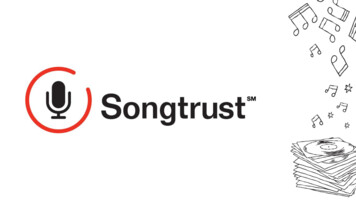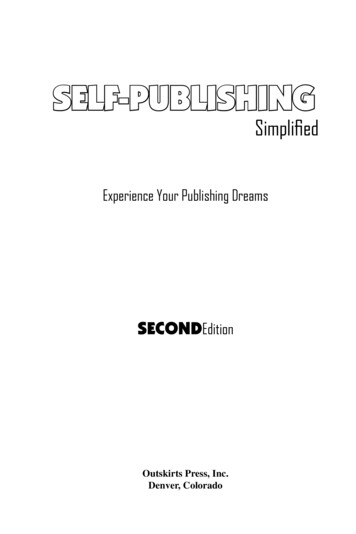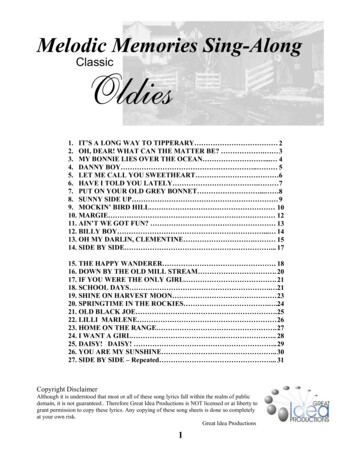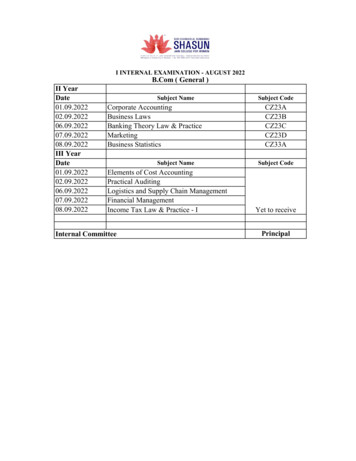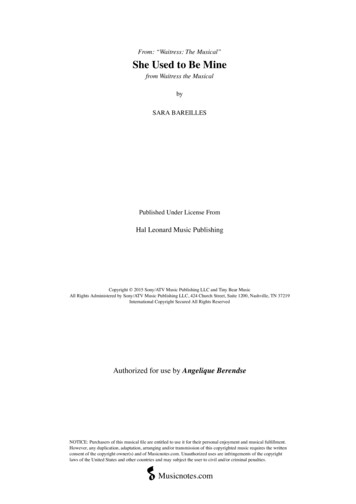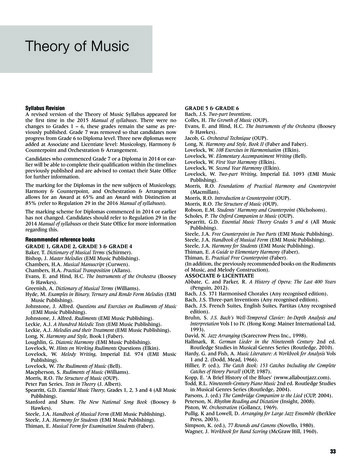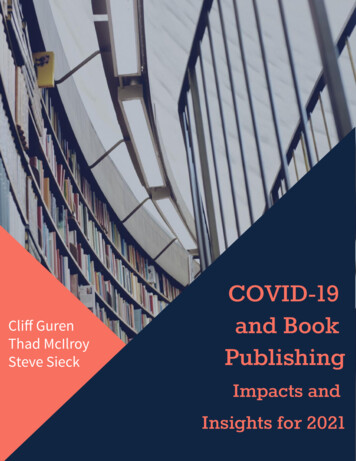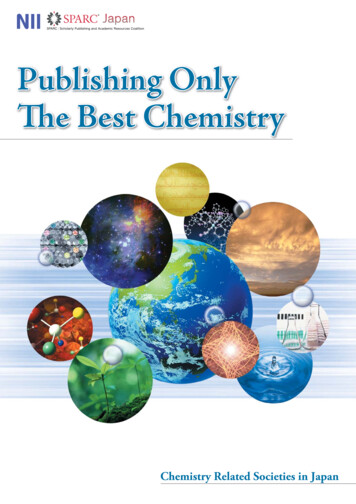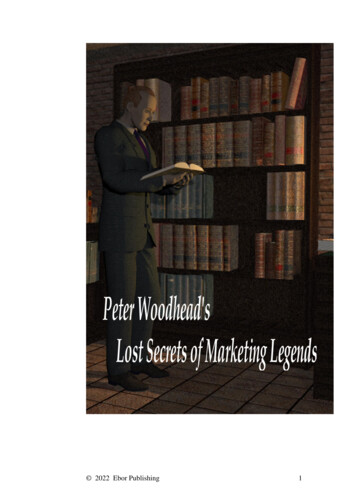
Transcription
2022 Ebor Publishing1
Peter Woodhead’sLost Secrets of MarketingLegends 2022 Ebor Publishing2
ContentsPageForeword by Yanik Silver4Introduction6Chapter One -Early Beginnings8Chapter Two -It All Started Right Here10Chapter Three - Science Applied to Advertising14Chapter Four -Writing Good Copy19Chapter Five -Psychology Applied to Advertising25Chapter Six -The Most Important Part of the Copy34Chapter Seven - A Good Letter Can Make You a Fortunein Direct Mail43Chapter Eight -Magic Words or Word Magic?53Chapter Nine -Today’s Direct Mail and CopywritingGeniuses62The Internet Age70Chapter Ten Conclusion -73Rogues Gallery -74 2022 Ebor Publishing3
Forewordby Yanik SilverMany people have asked me: “Yanik, to what single factor do youowe most of your success?”And I tell anyone who listens that a large part of my success can bedirectly attributed to a handful of little-known secrets of marketing.The same secrets that made John Caples, Robert Collier, DavidOgilvy, and others into marketing legends.Also the same secrets that helped Ted Nicholas, Jay Abraham, DanKennedy, Gary Halbert and others build Direct Mail empires.And the very same secrets that Internet gurus Corey Rudl, MarlonSanders, Alex Mandossian, and your truly all use today!No, they’re not some new viral marketing system, search enginetechnique, or opt-in strategy.So, what are these “secrets”?Surprisingly, the secrets to your success (either online or offline),can be found way back in history. The early marketers of the lastcentury (guys like John E. Kennedy, Claude Hopkins, Walter DillScott, Haldeman Julius, Elmer Wheeler, and others) knew whatmade people buy. They understood the psychology of why someads pulled and others didn’t.In fact, I’d wager 98% of today’s marketers don’t know about this (orknow all the names just mentioned).Frankly, I have tossed around the idea of putting together apackage of long lost advertising manuscripts but I could never setaside the time to do it justice.You see, I’ve recommended some of these hard-to-find classics tomany students and just about nobody took the effort to research allof them.Well, now you don’t have to. 2022 Ebor Publishing4
Peter Woodhead from the UK, took my suggestion to heart andactually spent a phenomenal amount of time researching andfinding these old masterpieces.He acquired the first book that I recommended, applied just one ofthe principles he found to his business, and had such a greatsuccess that he simply had to find out more. That’s when he beganhis research into other titles.Join me and (re)discover the marketing secrets that all topmarketers, including me, have been using to our advantage foryears.In addition to what you’ll find on this CD, Peter and I have packagedjust 4 of these out-of-print classics into a collection that you candownload, right here:http://www.longlostmarketingsecrets.comIf you’re serious about increasing your profits and gaining a definiteedge over your competitors, you simply must check out thecontents of this collection of masterpieces.You’ll be glad that you did.Sincerely, 2022 Ebor Publishing5
IntroductionThis Report is something completely different.It is a chronological “tour” of advertising since it first began with thevery first newspaper ad in 1704.Advertising, as we know it, probably started to prosper in 1904when John E. Kennedy gave the world that definition: “Advertisingis Salesmanship-in-Print”. A definition that has not been betteredsince – and many have tried.For me, modern day advertising started a few years earlier thanKennedy when Richard Sears produced the very first mail ordercatalog (around 1892). This catalog contained hundreds of pagesof articles for sale and each with their own sales copy. And SearsRoebuck is still going strong today.Around this time, advertising agencies sprang up everywhere. Andthe people they employed and trained, left us with such treasuresthat all top marketers today display in their resource libraries anduse to their advantage.Shortly after Kennedy arrived on the scene, Claude Hopkins camealong. He left us with a legacy we should all thank him for. Hepioneered market testing, sampling, vouchers, and a whole lotmore.At the turn of the last century there were many others: Walter DillScott, Maxwell Sackheim, Haldeman Julius, John Caples, to namejust four.Then around the middle of the century such geniuses as ElmerWheeler, Robert Collier and other contemporaries made their mark.Most of their works you will find in this “tour.”Post war, advertising greats David Ogilvy, Joe Karbo, also madetheir mark.And more modern legends Jay Abraham, John Carlton, GaryHalbert, Dan Kennedy, and Ted Nicholas, have all made manymillions both for themselves and their clients.Towards the end of the last century, the greatest marketing tool ofall time was unleashed on the world – the Internet. Early pioneer ofthe Internet, Ken McCarthy, is still around and his “System”seminars are an absolute must attend. 2022 Ebor Publishing6
The Internet has opened a whole new world for advertising andmarketing. And a new breed of entrepreneur has been born. Guyslike the late Corey Rudl, Marlon Sanders, Alex Mandossian, YanikSilver and many others have shown what can be done and in sucha short space of time.But one thing all these “gurus” have in common is that they havestudied the markets. They have studied the psychology of whatmakes people buy. They have learned these principles from thegreat masters of the past – the John Kennedy’s, the ClaudeHopkins’, the Walter Dill Scott’s, the Elmer Wheeler’s.And that’s what this “tour” is all about.You will be taken from the very beginnings of advertising and get aninsight into the writings, the ideas and the philosophies of most ofthe greatest marketers that ever lived.For sure, you will recognise much of the material that is mentionedas we take the “tour” but it’s doubtful that you will have come acrossall of it.All top marketers recommend that you continually add to youreducation and you will not do better than picking up any (or all) ofthe material that you will be exposed to on your “tour.”Every manuscript mentioned in this “tour” is a desirable addition foryour resource library.Pick them up, maybe one at a time. And you will profit from them –just like all the great masters have done – past and present.At the end of the tour we have complied a “Rogues Gallery”, a sortof quick synopsis of the great legends of the past. Apologies tothose that we’ve left out.Also, at the end of this Report are a few free manuscripts or firstchapter previews of manuscripts.Now, take the “tour.”My very best regards,Peter WoodheadEbor Publishing 2022 Ebor Publishing7
Chapter OneEarly BeginningsThis first Chapter is a brief history of events leading up to theappearance of John E. Kennedy.But it highlights a few milestones in advertising.1704 The first newspaper ad appeared. It was in a BostonNewsletter and sought a buyer for an estate in Oyster Bay,Long Island.1729 Benjamin Franklin starts to publish the Pennsylvania Gazettein Philadelphia – which included ads.1742 America’s first magazine ads published by Benjamin Franklinin General Magazine.1784 America’s first successful daily newspaper, the PennsylvaniaPacket and Daily Advertiser, starts in Philadelphia.1833 Benjamin Day publishes the first successful “penny”newspaper, The Sun. Circulation reached 30,000 by 1837which made it the largest in the world.1843 Volney Palow opens the first ad agency in Philadelphia.1868 Francis Wayland Ayer opens N. W. Ayer and Sons inPhiladelphia with just 250.His first clients include Montgomery Ward, JohnWannamaker Dept. Stores, Singer Sewing machines, andPond’s beauty cream.1873 The first convention for ad agencies held in New York.1877 J.W. Thompson buys Culter and Smith from William J.Carlton and pays 500 for the business and 800 for theoffice furniture.1880 Department Store founder John Wanamaker becomes firstretailer to employ a full-time advertising copywriter – John E.Powers. 2022 Ebor Publishing8
1881 Wannamaker makes famous statement: “half my advertisingis wasted, I just don’t know which half.”1881 Daniel M. Lord and Ambrose L. Thomas form Lord andThomas in Chicago.1882 Procter and Gamble advertise Ivory Soap with an enormousbudget of 11,000.1886 N.W. Ayer promotes advertising with the slogan: “Keepingeverlastingly at it brings success.”1886 Richard Warren Sears became the world’s first directmarketer.1891 George Batten and Co. opens.1892 NW Ayer hires first full-time copywriter.1892 Sears Roebuck formed.1893 Printer’s Ink founded by George P. Rowell. A magazine thatserves as the “little schoolmaster in the art of advertising.”1898 N.W Ayer helps National Biscuit Co. launch the first prepackaged biscuit Uneeda.1899 Campbell Soup makes its first advertising.1899 JWT becomes the first agency to open an office in London.1900 N .W. Ayer establishes a business-getting department toplan ad campaigns.1904 John E. Kennedy bursts onto the scene to change the face ofadvertising – forever.Go to Chapter Two to find out more. 2022 Ebor Publishing9
Chapter TwoIt All Started Right Here1904 It was on one May evening that a former Canadian mountie,John E. Kennedy, sent a note to the head of Lord andThomas.This is what the note looked like: 2022 Ebor Publishing10
Ambrose Thomas, the head of Lord and Thomas, dismissedthe note as arrogance. But his junior partner, Albert Lasker,spotted it and wanted to know more.This was Lasker’s reply:Lasker met Kennedy that first evening. And what Kennedyhad to say changed the face of advertising – and it stillapplies today.His statement was: “Advertising is Salesmanship-in-Print.” Itis a definition that no-one has been able to better to this day.Time-outPrint.Here’s our understanding of Salesmanship-in-There is no difference between ads, websites, newsletters,brochures, press releases, or being sat in front of yourcustomers - face to face.And to succeed at selling in print it is necessary to studyothers that have made a living at it, past and present.98% of marketers have no idea of how to sell in print.Therefore, study direct response marketers. They are theonly ones who can prove what works. Direct Marketing, bydefinition, is a method that sells its products without salespeople.It is always measurable. And the top direct marketers domeasure it.To succeed you need to make your sales process do thesame as if you were sat right next to your customer. 2022 Ebor Publishing11
Your website, sales letter, press release, newsletter,brochure, or anything else in print has to connect with yourprospects’ emotional hot buttons to persuade him or her totake some sort of action.Your advertising should not be about ‘image’ or ‘branding’, itshould be about telling your own unique story in a languagethat appeals to your prospects needs, wants, desires, fearsand vanity.Lasker related to what Kennedy talked about. He too hadbeen searching for many years to the answer that Kennedyhad now given him.Consequently, Kennedy was hired by Lord and Thomas andbecame the highest paid copywriter of the time. A massive 52,000 a year (some say even more).Lord and Thomas became a training ground for copywritersas Lasker got Kennedy to write all of his principles into aseries of lessons called: “The Book of Advertising Tests.”Kennedy left Lord and Thomas in 1907 but returned in 1911as a highly paid freelance copywriter. And in 1912 his Bookof Advertising Tests was re-published as “Reason WhyAdvertising” and in 1914 he wrote his second book “IntensiveAdvertising.”Time-outJohn E. Kennedy’s “Reason Why Advertising” became a bighit. But if you think about it, what a great title. It seemsobvious that you should give your customers a reason tobuy your product.But lots of advertisers, even today, do not. They merely say:“Buy my product.”They are making a big mistake of not explaining: “Buy myproduct because .”Are you making these mistakes in your marketing? 2022 Ebor Publishing12
1903 Walter Dill Scott produces his first book: “Theory ofAdvertising.”1906 WK Kellogg places his first ad for Corn Flakes in six midwestern newspapers. By 1915 he is spending 1 million onnational ads.1907 Kennedy leaves Lord and Thomas to “go it alone.” 2022 Ebor Publishing13
Chapter 3Science Applied to Advertising1908 Kennedy must have been a hard act to follow.But Lasker did replace him with a man who made an evengreater overall contribution to the advertising world thanKennedy did.Kennedy’s replacement was called Claude C. Hopkins.And what a true pioneer he proved to be.He’s the man who inaugurated free sampling, risk-free trials,money-back guarantees, and market testing, and muchmore.Hopkins agreed with Kennedy on the “Salesmanship onPaper” philosophy, but where Kennedy was a “one idea”man, Hopkins had many ideas.Hopkins reckoned that just placing ads and seeing whathappened was futile. Pure guesswork. He wanted tomeasure everything that he did.And we should all be glad that he did.Hopkins wrote only two books but both were classics. Hisfirst: “Scientific Advertising” written in 1923 contained manyof his secrets that he found with his testing techniques.These secrets are still as valid today.His second book, written in 1927, was an autobiographycalled: “My Life in Advertising.” Many regard this as the bestadvertising book ever written.All top marketers regard Hopkins’ first book as theircopywriting “how-to” bible.And the late advertising great, David Ogilvy, had this to sayabout the Scientific Advertising: “Nobody should be allowedto have anything to do with advertising until he has readScientific Advertising seven times – it completely changedmy life.” 2022 Ebor Publishing14
Jay Abraham, known as America’s #1 marketing wizard, hadthis to say: “Claude Hopkins is the master of them all. Hisinfluence has easily added over 6m to my personalincome .and still counting.”Hopkins created ad campaigns for many major UScompanies that are still going strong today. Companies suchas Palmolive, Pepsodent, and Quaker Oats.One of his secret strategies for creating more turnover for hisclients was that of “pre-emptive” strikes.Time-outIn fact, Hopkins himself never used the word “pre-empt” butthat was what he was doing. The word was used later byRosser Reeves and also by Jay Abraham.By this strategy, he used to tell a story of how things weredone in an industry and thus educate the customers. Anycompetitors could have told the same story but didn't. andwhoever did so first, gained the edge.Hopkins stated in his books that a large part of advertisingdone at the time was based on the concept of: "Buy MyProduct" or "Come into My Store." Lots of advertisers todaymake this same mistake. Are you one of them?Customers are not fooled by this. They want to know:"What's in it for me?"Hopkins knew this and used this psychology to grow VanCamp's pork and bean business. After his research, Hopkinsfound that 94% of housewives were baking their own beansat home and only 6% were buying canned beans.But Hopkins realized that everybody advertising cannedbeans merely stated: "Buy My Brand." Nobody explainedwhat the benefit of their product was. 2022 Ebor Publishing15
Time-outJohn E. Kennedy also knew this. That why he re-publishedhis book: "Reason Why Advertising." He had already workedout, years before Hopkins, that you had to give yourprospective customers a "reason why" they should buy yourproduct.So, Hopkins ran an advertising campaign that explained howit took 16 hours to bake beans at home, and you could nevermake home baked beans digestible.He talked about crispy beans on top and the mushy beanson the bottom. He also highlighted the process Van Camp'sused to select their beans, the soft water that they used, andhow they made the skins less tough by removing the lime.He also emphasized the steam ovens where the beans werebaked at 245 degrees in sealed containers so no flavor waslost. Then finally he offered a free sample so customerscould compare.This particular campaign became a huge success for VanCamps. Yet it was the very same process that all themanufacturers could have told. But they didn't.Here's another famous story from Claude Hopkins which youmay have heard of.Schlitz Beer were ranked 5th. in their share of the market.That was, until they hired Hopkins to do his makeover.At the time, every beer manufacturer was advocating thattheir brand was "pure." But consumers thought: "who cares,"that was until Hopkins worked his magic and actuallyexplained what was meant by "pure."Hopkins knew that he had to understand the whole processof beer making so he was taken on a factory tour where hewas shown plate-glass rooms where beer was dripping overpipes. This, he was told, was so that those rooms filled withfiltered air, so the beer could be cooled in without impurities.Then he was shown huge and very expensive filters filledwith white-wood pulp that provided a superior filteringprocess. The manufacturer explained how every pump and 2022 Ebor Publishing16
pipe were cleaned twice a day to ensure purity. Also, everybottle was sterilized not once, or even twice, but four timesbefore being filled with beer.The Schlitz factory was located right on the shores of LakeMichigan, which at the time was not polluted and could haveprovided clean water, but no, Schlitz got their water from4,000 foot deep artesian wells to ensure that the water wasthe cleanest and purest it could possibly be.And at the end of his tour, Hopkins was shown into alaboratory and shown the mother yeast cell, that took 1,200experiments to reach the required robust flavor. All Schlitzbeer was developed from that original yeast cell.Hopkins was truly amazed and asked why the companydidn't tell their customers all this. Their reply was: "becauseall beer manufacturers do it this way."And Hopkins replied: "Yes, but nobody has ever told thestory."Hopkins' campaign took Schlitz from that 5th. spot to equal1st. spot in just a few months.What Hopkins did in these two examples and all the othershe created, was educate people. The same is true today.You cannot over-educate people.Now maybe you're still thinking, anything from as long ago asthe beginning of the last century can't possibly work today.Then think again.Time-outMaybe your business operates in exactly the same way asyour competitors. How do you gain an edge?Take time to write down exactly what you do. Cover yourwhole process from "cradle to grave." For sure, you willcome up with some of your own "pre-emptive" strikes.Do what all the top marketers do. Read, and re-read, ClaudeHopkins' "Scientific Advertising."1908 Walter Dill Scott produces another classic on advertising:“Psychology of Advertising.” Maxwell Sackheim said this 2022 Ebor Publishing17
about this classic manuscript: “The only book on advertising Iread as a youth was written by Professor Walter Dill Scott ofNorth Eastern University and was titled: “The Psychology ofAdvertising.” l still think it is one of the finest books everwritten on the subject – and that his formula for successfuladvertising has never been surpassed.1911 Kennedy returns to Lord and Thomas as a freelancecopywriter.1911 Proctor and Gamble pay JWT to launch Crisco, its newvegetable shortening.1911 Standard Oil, dissolved by the courts, invites Harrison KingMcCann to form an agency to service its disbandeddivisions.1911 Woodbury Soap launches its “The skin you love to touch”campaign. The first time “sex” appeal was used inadvertising. 2022 Ebor Publishing18
Chapter FourWriting Good copy1912 Ask any top marketer today and they may tell you that thesecret to their success is attributable to two things:1. the ability to write, and recognise, good copy2. knowing what makes people buyIf you understand these two points, and understand themwell, you will make your fortune. No doubt about it!And it doesn’t matter if you sell your product or serviceonline, or offline, the two principles above are still valid.Think about it. What’s the point of having sexy-lookingwebsites or graphically designed sales letters if they don’tconvert prospects into customers. Who are you trying toimpress? You need sales. You need conversions.Time-outClaude Hopkins wrote: “Your marketing only works if it sells.”And John W. Blake in his book: ”Blind AdvertisingExpenditure” wrote: “ there is only one justification foradvertising. Sales! Sales! Sales!“You don’t need to be a genius writer to succeed. WilliamShakespeare was a writer. Charles Dickens was a writer.Stephen King is a writer. But you don’t have to be in thatleague. You need to write as if you are sat next to yourprospect and all you need to use are the right words.It’s using the right words that will get you those sales.Here’s an extract from a 1912 advertising magazine: 2022 Ebor Publishing19
What Good Copy IsIt has been said that Advertising space without goodcopy is like the wooden Indian in front of a cigarstore: It locates the store but it doesn't sayanything.Years before the value of advertising copy wasrealised, most advertisers. especially in small towns,bought space in their local papers to print anadvertisement that read something like thefollowing:JOHN JONESFurniture150 Main StreetNowadays, nearly all markets, even in the smallercommunities, have learned something about goodcopy.A jeweller instead of simply telling that he is in thejewelry business will select articles from his stockthat are good value for money, illustrate anddescribe them in his advertisements and quoteattractive prices.Copy must be terse, clear cut, and to the point. Itmust consist of short, crisp sentences. Long wordsshould be avoided where possible. This is a busyworld. Few people have time for long-windeddescriptions and explanations.Time outWinston Churchill said: "Short words are best, andthe old words when short are best of all."Good advertising copy does three things: First:Attracts Attention. Second: Interests the reader.Third: Convinces the reader. 2022 Ebor Publishing20
Attracting AttentionThe first mission of an advertisement, as stated, isto attract attention. The attention of the reader maybe secured by pictures, trade marks, strikingheadlines, unusual border designs, etc. Which ofthese methods used depends altogether upon thearticle advertised.In advertising the majority of articles, the best plan isto show a good picture of the thing itself. A trademark is valuable as an eye-arrester and whenemployed over and over again in the advertising, itis not easy for the reader to escape theadvertisement at the first glance.Interesting the ReaderTo make your advertising interesting, you must notonly set forth the merits and quality of the articleadvertised, but you must make clear how it willbenefit the purchaser.For example, if you are advertising a moving picturemachine for use in the home, you will, of course, tellabout its fine construction, simplicity of operation,clear cut reproduction of pictures etc. Then pointout the great benefit to be derived from theownership of such a machine. Tell how it willentertain the whole family and their friends bothyoung and old. How it will help to keep the boys athome in the evenings. How, in addition to beingentertaining and amusing, the geographical, animal,horticultural, and industrial subjects will educate anddevelop the children in a fascinating way.In selling an automobile the important thing toadvertise is not the automobile itself, but what thepossession of the automobile means to thepurchaser. The thing to advertise is the pleasurethat the car affords; the joy and healthfulness ofriding through the country, getting to and from yourhome to place of business with the maximum speed,ease and comfort; how it makes it convenient to callon distant friends, etc. etc.To tell what the article advertised will do for thepurchaser in the way of entertainment, education,comfort, convenience, etc., is really moreimportance than the thing itself. 2022 Ebor Publishing21
Convincing the ReaderIt has been said that no man can write a convincingadvertisement unless he believes what he is writing.The advertisement that brings the best results is theone that is written by the man who honestly believesin the goods that he is selling.Therefore, it is not advisable to handle anythingunless one believes it to be a worthy article at a fairprice that will please the purchaser.If you know that what you offer has merit and isfairly priced you can then talk and write about it in aconvincing manner. Know that the offer you aremaking is a good one and you will then be able toconvince your prospective customer.It has been said that a salesman must first sell tohimself before he can sell it to others. That meansthat you must first satisfy yourself that the article youare selling is good enough for you to buy at the priceyou are asking, provided you need or want such anarticle.It is not what is said in an advertisement that carriesconviction, but how it is said. A man may read yourannouncement, but unless he is convinced by whathe reads, he does not buy, and your advertisement,in his case, has failed.Advertising to "bring home the bacon" must haveinjected into it the vital element of salesmanship.No matter in how many periodicals you advertise, nomatter how many letters you send out, you will fail, ifyour advertisements and your letters do not containa selling force. Now what is selling force orSalesmanship? On this point let us quote RobertRuxton, a well-known advertising authority:"The ordinary advertiser must not alone bring hismessage before the public, but bring it in such away as to convince. Here we strike another axiomof selling: It is not what is said, but the way it is saidthat counts."The plot of the great masterpieces of fiction can betold in few words. It's the method of relation thatmakes them famous. Hawthorne speaks of 'The 2022 Ebor Publishing22
unaccountable power that lurks in a syllable' - of thisTennyson, like Hawthorne, was master, he grippedthe mind of the reader with a few magic words. Thispower is the power of Salesmanship no less than offiction. One man convinces by what he writes; theother does not - that is the difference."Preparing AdvertisementsThe usual advertisement consists of three parts the heading, the body and the address. Unless theadvertisement is illustrated, the heading is of utmostimportance because you depend on it to attract theattention and secure interest of the reader.Large city newspapers employ headline writerswhose duty it is to write attractive heads for all theimportant news articles. This shows the valueplaced upon good captions even for news articles.Good headlines are more important for advertisingthan for news articles because people will read thenews in spite of weak headlines, but few people willread advertisements unless they are attracted bythe headlines. If the headline catches the reader'seye, he will undoubtedly read the body of theadvertisement.Time-outJohn Caples wrote: "On average, 5 times as manypeople read the headline as read the body copy.Therefore, unless your headlines sell your product,you've wasted 90% of your money.The best headlines are those which promise thereader a benefit - a whiter wash; more miles pergallon."The Choice of WordsGood advertising copy consists, as you have nowlearned, of a combination of words that convince thereader that he should do as the advertising directs. 2022 Ebor Publishing23
Therefore, to become a successful advertiser, youmust study words and learn to combine them in away that will express thought with force andconviction.Don't use too many adjectives, as they are likely tospoil an otherwise good advertisement. The buyingpublic will be more easily convinced by the use ofdecisive words of praise in description of wares,than by what are known as "gushing" adjectives,which, however appropriate, will mean but little ifthey are too freely used.Have a care for the proper use of words and you willfind that far fewer words are required to expressyour exact meaning.Do not deviate from "plain everyday speech" simple, clean cut, incisive language.Express yourself as simply as possible, for simplicitymakes for efficiency at all times.Unusual words, words of many syllables, long,involved sentences, complex phraseology, shouldbe avoided.Advertising should always be written for the onepurpose of attracting and convincing the largestpossible number of its readers and never for thepurpose of exhibiting either your education or yourcleverness.Time outTed Nicholas, "The Guru of Direct Mail Marketing,"had this to say: "Certain words produce amazingresults, as if by magic."All you desire in life, including everlasting wealth,can be yours depending on the words with whichyou express yourself. It doesn't matter whether thewords are written or spoken, either. As with all thegreat truths, once known, they seem so simple." 2022 Ebor Publishing24
Chapter FivePsychology Applied to Advertising1912 Now, consider point #2 from page 19Knowing what makes people buy.This is probably the least understood principle in marketing.The fact is, people have been sold to by the sametechniques for centuries.Why?Because human emotions haven’t changed over time –and they never will.People buy for the same reasons now as they did 100years ago, even 10,000 years ago.Understand what it is that makes people buy and you willsucceed. And succeed beyond your wildest dreams.And to understand this you will need to do what all topmarketers have done, and that is to study those that havemastered the technique. To help you in this respect, here isan article from an old manuscript written in 1912. We will, ofcourse, recommend some other resources.Here’s the extract:Psychology of Advertising and SalesmanshipPsychology, we are told, is the science of themind. Now the "science" of a thing is simply thetruth about the thing. Therefore, the "science" ofthe mind is the truth abo
And the very same secrets that Internet gurus Corey Rudl, Marlon Sanders, Alex Mandossian, and your truly all use today! No, they're not some new viral marketing system, search engine technique, or opt-in strategy. So, what are these "secrets"? Surprisingly, the secrets to your success (either online or offline),
